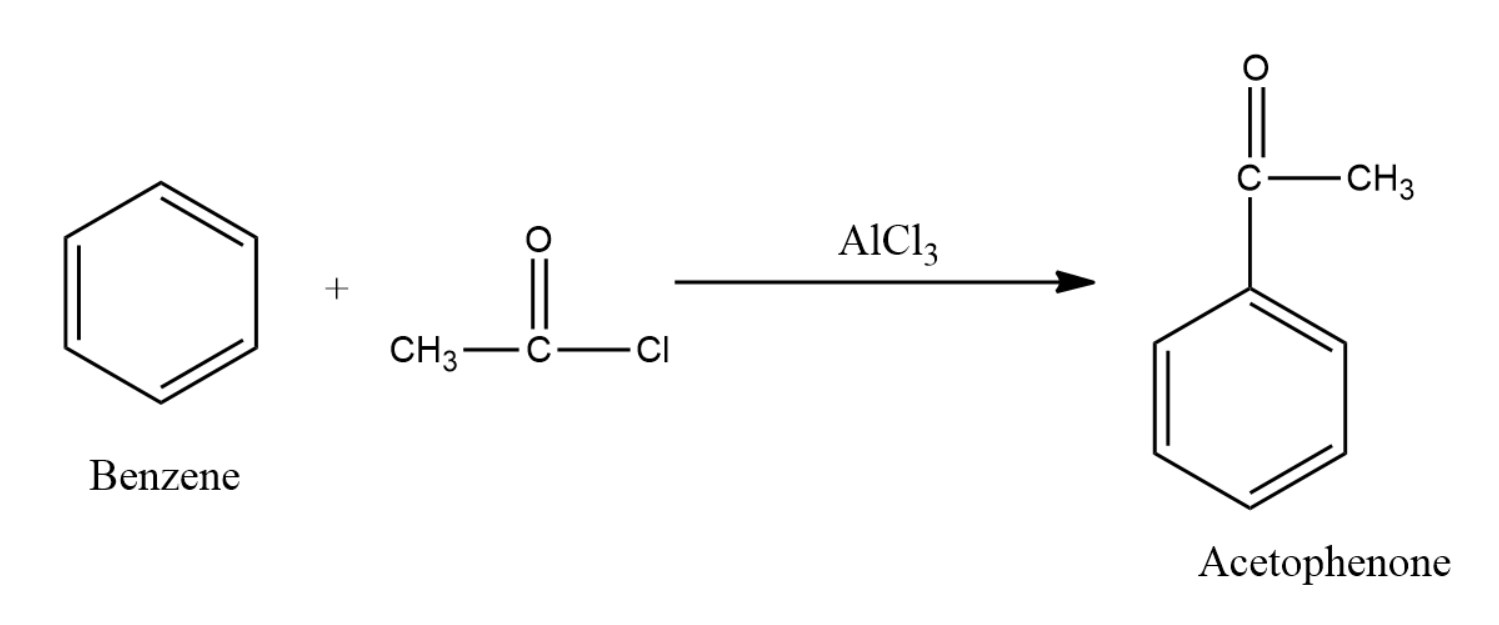
Benzene reacts with
A.
B.
C.
D.
Answer
408.6k+ views
Hint: The Friedel–Crafts acylation is a very important organic reaction of an arene with an acyl chlorides or acid anhydrides in the presence of a strong Lewis acid catalyst like anhydrous
Complete answer:
Benzene is a very popular example of an arene and it will undergo Friedel-Crafts acylation when treated with acyl chloride in the presence of a Lewis acid such as
The mechanism of the reaction is as shown below:
The first step in this mechanism is the activation of the electrophile by using the Lewis acid. Lewis acid coordinates to the halogen in the acyl halide, and departure of the halogen as

The acylium ion is the active electrophile in the Friedel-Crafts acylation reaction. Once formed, the acylium ion is attacked by the aromatic ring in this case the benzene molecule. The final step of this reaction is deprotonation at carbon to regenerate the aromatic ring.
Thus the reaction can be written in general as:

Thus the correct option is option (D) .
Note:
There is a similar reaction to acylation known as the Friedel-Crafts Alkylation. Friedel-Crafts Alkylation reaction refers to the replacement of an aromatic proton with an alkyl group by using an alkyl halide. This reaction is done through an electrophilic attack on the aromatic ring by the help of an alkyl carbocation. The Friedel-Crafts alkylation reaction is a very useful method for generating alkyl benzenes by using alkyl halides as reactants.
Complete answer:
Benzene is a very popular example of an arene and it will undergo Friedel-Crafts acylation when treated with acyl chloride in the presence of a Lewis acid such as
The mechanism of the reaction is as shown below:
The first step in this mechanism is the activation of the electrophile by using the Lewis acid. Lewis acid coordinates to the halogen in the acyl halide, and departure of the halogen as

The acylium ion is the active electrophile in the Friedel-Crafts acylation reaction. Once formed, the acylium ion is attacked by the aromatic ring in this case the benzene molecule. The final step of this reaction is deprotonation at carbon to regenerate the aromatic ring.
Thus the reaction can be written in general as:

Thus the correct option is option (D) .
Note:
There is a similar reaction to acylation known as the Friedel-Crafts Alkylation. Friedel-Crafts Alkylation reaction refers to the replacement of an aromatic proton with an alkyl group by using an alkyl halide. This reaction is done through an electrophilic attack on the aromatic ring by the help of an alkyl carbocation. The Friedel-Crafts alkylation reaction is a very useful method for generating alkyl benzenes by using alkyl halides as reactants.
Recently Updated Pages
Express the following as a fraction and simplify a class 7 maths CBSE

The length and width of a rectangle are in ratio of class 7 maths CBSE

The ratio of the income to the expenditure of a family class 7 maths CBSE

How do you write 025 million in scientific notatio class 7 maths CBSE

How do you convert 295 meters per second to kilometers class 7 maths CBSE

Write the following in Roman numerals 25819 class 7 maths CBSE

Trending doubts
State and prove Bernoullis theorem class 11 physics CBSE

What are Quantum numbers Explain the quantum number class 11 chemistry CBSE

Write the differences between monocot plants and dicot class 11 biology CBSE

1 ton equals to A 100 kg B 1000 kg C 10 kg D 10000 class 11 physics CBSE

State the laws of reflection of light

One Metric ton is equal to kg A 10000 B 1000 C 100 class 11 physics CBSE




